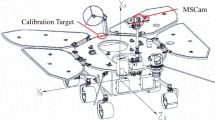Abstract
Mars Orbiter Mission (MOM) is ISRO’s first interplanetary mission. Orbit determination of the spacecraft is always challenging especially for interplanetary missions. It is more difficult when the supported ground stations and the observations are limited. Presently, MOM is being supported by only ISRO’s 32-m antenna for a limited duration. Spacecraft is always facing a lot of disturbances from the sun and various disturbances in Martian orbit. Limited observation data from the ground station resulted in uncertainties in MOM’s orbit. In this paper, efforts are made to tune the MOM’s orbit based on its captured image by its camera and the spacecraft attitude information from the telemetry. Starting from the available coarse orbit information, the orbit parameters were tuned such that the tuned orbit and attitude can produce an image which is exactly matching with the observed one. The paper explains the principle of tuning the parameters using suitable image processing techniques, the System Tool Kit (STK) and MATLAB software. The method described in this paper can be implemented to any interplanetary satellites for orbit tuning as it can be implemented in on-board computer itself. Using present coarse knowledge of orbit, accurate attitude from star sensor, the spacecraft can generate features of the expected reference image. The observed and reference image difference can be used to tune present orbit as done in this paper.
Access this chapter
Tax calculation will be finalised at checkout
Purchases are for personal use only
Similar content being viewed by others
References
Hobbs D, Bohn P (2006) Precise orbit determination for low earth orbit satellites. Ann Marie Curie Fellowships 4:128–135
Vatansever S, Butun I (2017) A broad overview of GPS fundamentals: now and future. https://doi.org/10.1109/CCWC.2017.7868373
MacArthur JL, Posner AS (1985) Satellite-to-Satellite range-rate measurement. In: IEEE Trans Geosci Remote Sens GE-23(4):517–523. https://doi.org/10.1109/TGRS.1985.289443
Pillai SU, Himed B, Li KY (2006) Effect of earth’s rotation and range fold over on space-based radar performance. IEEE Trans Aerosp Electron Syst 42(3):917–931. https://doi.org/10.1109/TAES.2006.248188
Garcia-Escartin JC, Chamorro-Posada P (2015) Repeaters in relativistic communications. IEEE Trans Mol Biol Multi-Scale Commun 1(2):158–163. https://doi.org/10.1109/TMBMC.2015.2501742
Mateus P, Nico G, Catalao J (2015) Uncertainty assessment of the estimated atmospheric delay obtained by a numerical weather model (NMW). IEEE Trans Geosci Remote Sens 53(12):6710–6717. https://doi.org/10.1109/TGRS.2015.2446758
Michalak G, Neumayer KH, Konig R (2020) Precise orbit determination of the kepler navigation system—a simulation study. https://doi.org/10.23919/ENC48637.2020.9317467
Putnam ZR, Clark IG, Braun RD (2012) Drag modulation flight control for aerocapture. https://doi.org/10.1109/AERO.2012.6186999
Cao J, Clemente C, McInnes CR, Soraghan JJ (2020) Solar radiation pressure enabled femto satellite-based earth remote sensing. IEEE Trans Aerosp Electron Syst 56(5):3450–3461. https://doi.org/10.1109/TAES.2020.2972242
Manikantan R, Aravind B, Dai BK, Mishra PD, Sonnada M, Srinivasan R (2019) Delta-DOR correlator development at ISTRAC/ISRO. In: 2019 URSI Asia-Pacific radio science conference (AP-RASC). IEEE, pp 1–1
Oshman Y (1999) Spacecraft attitude/rate estimation using vector-aided GPS observations. IEEE Trans Aerosp Electron Syst 35(3):1019–1032. https://doi.org/10.1109/7.784071
https://towardsdatascience.com/canny-edge-detection-step-by-step-in-pythoncomputer-vision-b49c3a2d8123. Accessed March 2022
Acknowledgements
The authors acknowledge the Indian Space Science Data Center (ISSDC) and Space Application Center (SAC) of Indian Space Research Organisation (ISRO) for providing the actual MOM’s Mars Color Camera (MCC) data. This image files were key source for this paper. The authors also acknowledge the contribution of ISRO Telemetry, Tracking and Command Network (ISTRAC)-Flight Dynamics Group (FDO) team who has provided initial state vector of MOM. The authors also acknowledge all the Deputy General managers and managers of SOG-1 and 2 of Spacecraft Operation Area (SpOA)-ISTRAC for providing the opportunity to work in this project.
Author information
Authors and Affiliations
Corresponding author
Editor information
Editors and Affiliations
Rights and permissions
Copyright information
© 2023 The Author(s), under exclusive license to Springer Nature Singapore Pte Ltd.
About this paper
Cite this paper
Joarder, R., Dai, B.K., Nagaraju, K., Roopa, M.V., Ramakrishna, B.N., Choudhary, R.K. (2023). Estimation of Mars Orbiter Orbit Based on Mars Color Camera Images. In: Kumar, S., Setia, R., Singh, K. (eds) Artificial Intelligence and Machine Learning in Satellite Data Processing and Services. Lecture Notes in Electrical Engineering, vol 970. Springer, Singapore. https://doi.org/10.1007/978-981-19-7698-8_2
Download citation
DOI: https://doi.org/10.1007/978-981-19-7698-8_2
Published:
Publisher Name: Springer, Singapore
Print ISBN: 978-981-19-7697-1
Online ISBN: 978-981-19-7698-8
eBook Packages: EngineeringEngineering (R0)




